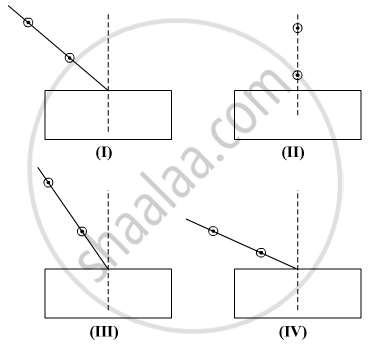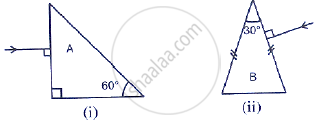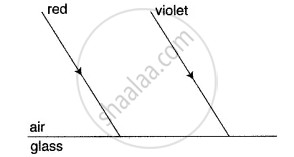Advertisements
Advertisements
Question
Select from the following the best set-up for tracing the path of a ray of light through a rectangular glass slab:

(A) I
(B) II
(C) III
(D) IV
Solution
(A)
The best set up is given in figure (I). The incoming light should not fall perpendicularly as the light will emerge straight and refraction cannot be traced. The light rays should not be very close or far from the normal as the emergent rays are difficult to trace.
APPEARS IN
RELATED QUESTIONS
Define refraction and state the laws of refraction.
Draw a ray diagram to show the refraction of a monochromatic ray through a prism when it suffers minimum deviation
Draw the diagram of refraction of light in the glass slab
Fig 4.31 below shows a light ray of single colour incident normally on two prisms A and B. In each case draw the path of the ray of light as it enters and emerges out of the prism. Mark the angle wherever necessary.

After tracing the path of rays of light through a glass slab for three different angles of incidence, a student measured the corresponding values angle of refraction r and angle of emergence e and recorded them in the table given below:
|
S. No. |
∠i |
∠i |
∠e |
|
I |
30° |
20° |
31° |
|
II |
40° |
25° |
40° |
|
III |
50° |
31° |
49° |
The correct observations are:
(A) I and II
(B) II and III
(C) I and III
(D) I, II and III
State the factors on which the angle of deviation depends.
Comment on the statement ‘The refractive index of glass is 3/2.’
Express the refractive index μ of a medium in terms of the velocity of light.
What do you understand by the deviation produced by a prism?
Two parallel rays of Red and Violet travelling through the air, meet the air-glass boundary as shown in the above figure. Will their paths inside the glass be parallel? Give a reason for your answer.

